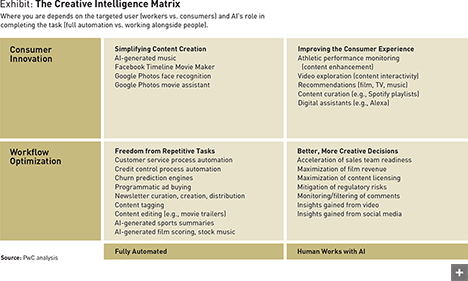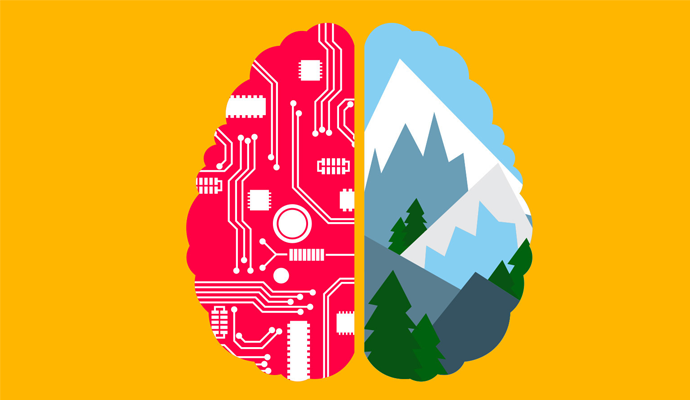AI is already entertaining you
How technology endowed with creative intelligence changes the way companies generate and distribute content.
In the fall of 2016, a pop song was released in Japan. “Daddy’s Car,” derivative of a Beatles tune, had a soothing beat and vaguely uplifting lyrics: “Good day sunshine in the backseat car / I wish that road could never stop.” The ditty was distinctive for its authorship. Sony’s Computer Science Laboratories in Paris produced the song, which was written by an artificial intelligence (AI) system called Flow Machines. The melody and harmony were composed by AI, and a human musician mixed the sound and wrote lyrics for the track.
AI — the new set of technologies that perform tasks that require human intelligence, such as speech recognition, decision making, and learning — is rapidly working its way into business operations within many global industries. Some members of the entertainment and media (E&M) industry have downplayed its potential. After all, these are creative industries in which both the germ of the business and the value added to it stem from the contribution of human ingenuity and people exchanging ideas. The most successful E&M products and services rely on connecting creative content, brands, and experiences with audiences.
The more creative you are, the conventional wisdom holds, the more protected you are, or the less able you are to benefit from the many advances in technology. And skepticism seems justifiable when it comes to the ability of machines to be truly creative. In PwC’s Consumer Intelligence Series (CIS) survey, 24 percent of respondents said AI could, by 2025, create a Billboard Hot 100 song, but only 12 percent said it could write a New York Times bestseller and 7 percent said it could win a Pulitzer.
And yet AI is already very much present in the creative industries, just as it is exerting an influence on financial services, healthcare, manufacturing, and most other industries. Which isn’t surprising. Whether in the form of digitization or social networking, the E&M industry has long had the necessary levels of creativity, content, technology know-how, and consumer passion to kick-start innovation. Throw in the low level of legal, financial, and regulatory barriers surrounding business models in entertainment and media, and you have a natural proving ground for new technologies.
Artificial intelligence is starting to transform the role of creativity — in the factors of both production and customer experience. You can see the impact clearly at two extremes in virtually every market: in startups, where innovation and disruptive media models are tested, and in industry giants that are facing an urgent need to alter their 20th-century processes, technology, and structures.
Working Hand in Hand
As AI becomes more powerful, a sense persists in the entertainment and media industry that there is a trade-off between creativity, ingenuity, compelling content, and originality on the one hand, and standardization, scale, optimization, and repetition on the other. Left brain and right brain. Instinct and execution. Creativity develops the concept, the film, the ad campaign, the song, the app; standardization is required to turn it into a marketable product, a functioning, scalable business. In this view, creative work is the preserve of humans, and if AI can play any role, it will be in a small way. Left entirely to its own devices, the thinking goes, technology would produce bland material, or, worse, go off the rails.
AI is already very much present in the creative industries, just as it is exerting an influence on manufacturing and most other industries.
But this polarized view takes into account only the extremes — as if every ad jingle writer is Mozart and every computer is HAL from 2001: A Space Odyssey. We have been conducting extensive consumer and executive research via surveys, and holding conversations with leaders throughout the E&M and technology, media, and telecom sectors. And we’ve concluded that the reality lies between these two extremes. AI has the potential to help transform companies by reimagining the ways in which people and machines interact — as workers, content creators, and consumers. It is possible for AI to reach deep into companies’ core operations to foster creativity and originality at scale. When it comes to creative intelligence, in fact, the purported trade-off between humans and machines may in fact be a set of synergies. As technology leaders will tell you, AI is an industrial advance on a par with the arrival of electricity — it’s that big (see “Human vs. Machine”).
Human vs. Machine
Historically, the advent of powerful technologies has inspired equal doses of fear and hope. But something is particularly compelling and terrifying about AI, which clearly has the potential to displace labor. Our most recent PwC UK Economic Outlook suggests that up to 38 percent of U.S. jobs and 30 percent of U.K. jobs are at high risk of being automated by the 2030s. We know that the most “at risk” jobs are those that are repetitive, process-driven, and rules-based, such as administrative support positions or bank teller jobs. Rather than fighting the process, companies should consider devoting resources to skills training for the many service and manufacturing workers who will be displaced by machines, and preparing them for the new jobs that will emerge.
Grappling with new technologies will be unavoidable for leaders because of two important structural forces driving AI. First is the supply of new products, services, and platforms. The typical person’s media diet is, in effect, already designed by computer-based nutritionists. Every day, millions of Spotify listeners take their cues from AI-generated playlists. During one National Novel Generation Month (NaNoGenMo), coders wrote programs that, in turn, generated some 500 novels. “For me, asking if a business can benefit from AI is like asking if a business can benefit from the Internet,” said one leader. “It is that fundamental a shift in technology. If you don’t figure out how to use it and benefit from it, you are going to go out of business. Your competitors will destroy you.”
The second structural force is demand. The industry shift is being driven by consumers’ desire to move to a world in which they have greater customization, spontaneity, and personalization in the way they consume content, communicate, and engage in commerce. More than half (55 percent) of millennials in the CIS survey said they would like to select their media by curating a list that draws heavily on AI recommendations, or simply have it selected altogether by a bot. The acceleration of AI is arriving just in time to meet the demand for new forms of digital experiences, to cope with the growing complexity of curating and accessing digital media, and to address evolving concerns about security and privacy.
Thus considered, AI is both a strategic imperative and an immense opportunity — to improve efficiency, create new and better user experiences and products, free up human labor for more intense creative efforts, and contribute to value creation. It can be applied to all areas of corporate endeavor: process, monetization, distribution, and creative work. To date, many companies have been in AI denial. Some are beginning to experiment, focusing on specific activities (e.g., the back office or customer service). Others are taking a strategic, organization-wide view. But in order to make the most of AI, leaders have to learn to think more analytically about the challenges and opportunities at hand.
Grasping Opportunities
No single path is best for integrating AI into the E&M business. The key is to understand the dimensions in which AI can aid, abet, optimize, enhance, and, yes, occasionally replace human work — and to learn from what companies are already doing. Next, prioritize the opportunities and assess whether your current capabilities will allow you to pursue AI effectively. Doing so will either free up resources or impose new requirements on you and your colleagues.
Drawing on our interviews with clients who are leading this work for their organizations today, we’ve created an illustrative framework of organizing principles for evaluating AI projects. This approach examines the use of AI tools and strategies in two dimensions (see exhibit). One (the vertical axis) considers whether the functions are aimed primarily at optimizing existing workflows or primarily at creating innovations in the consumer experience. The other (the horizontal axis) considers whether the activities involve people working alongside AI or whether the functions are fully automated. We should note that the assumption typically applying to a 2x2 matrix, in which the lower left quadrant is for underperformers and the upper right is home to the most evolved companies, doesn’t necessarily apply here. In fact, significant business value can be derived in each quadrant. Companies may have activities and initiatives that fall into multiple quadrants. The level of investment in each quadrant depends on an organization’s views about value creation and protection, its appetite for change, its risk profiles, and its ability to execute.
Freedom from Repetitive Tasks
Because of the availability of proven, off-the-shelf artificial intelligence solutions, many companies start in the lower left quadrant — automating processes, often in human resources and finance. Many media companies have lagged in putting effective back-office processes and technology into place. Thus, the potential for the application of AI is great. One U.K. media company that is a leader in the exhibitions industry is experimenting with back-office automation, and expects it will help the company boost margins from activities such as credit control and customer acquisition.
But these efforts aren’t confined to the back office. Historically, the out-of-home ad industry hasn’t kept up with other media-buying trends. One of the brands within a large ad holding company in Japan developed an AI-based solution for making purchasing decisions on out-of-home advertising locations, such as billboards. By deploying bots, the unit has automated the online bidding process for clients.
Efforts aimed at creating content can also fall into this quadrant. News services (for example, the Associated Press) are now using AI platforms such as Wordsmith to generate short articles that summarize a baseball game via statistics or that are based on the earnings reports of publicly held companies. A movie studio has used IBM’s Watson to create trailers. By watching an entire film and selecting six minutes’ worth of scenes, the AI solution can do in less than 24 hours what normally takes 10 to 30 days. When Shelly Palmer, a leading media technology consultant, publishes his daily newsletter, he writes one new article and algorithms aggregate additional articles (see “Media’s Data-Driven Future,” by Deborah Bothun and Art Kleiner). Next, AI generates four versions of the newsletter, one aimed at maximizing engagement, another at maximizing clicks, and so on. Programs then mine data on subscribers to determine which of the four versions will be sent to each recipient.
Better, More Creative Decisions
A useful rule of thumb says that if you have a playbook for managing a work process — editing and publishing a magazine, distributing a film, planning an advertising campaign — algorithms can be developed to help execute the playbooks more effectively. AI can work alongside people to carry out tasks that are complex yet repeatable, thus generating powerful insights and freeing up time that professionals can use to make more intelligent decisions, as seen in the exhibit’s lower right quadrant.
Studios are getting better at applying advanced analytics and real-time feedback to shape their marketing campaigns. Using an analysis of initial uptake and social chatter surrounding a new movie release, one studio is using an AI-powered solution that makes recommendations for marketing and monetizing the content across downstream windows such as premium cable and video-on-demand platforms. Beyond measuring eyeballs for content aired at a specific time, the new “data factories” that studios are constructing allow them to measure, and often help direct, a consumer’s online journeys and actions.
Movie studios are getting better at applying advanced analytics and real-time feedback to shape their marketing campaigns.
A major U.S. digital company is developing an AI-powered interface for its ad sales team. When ad reps input information on upcoming client meetings, the tool provides recommendations on which individuals to target, challenges that have arisen in previous campaigns, and which ad products and types of campaigns will be especially compelling to the client.
One of the most powerful contributions AI can make is to shed light on emerging preferences for people who are designing products intended to appeal to large audiences. An advertising holding company in the U.S. has teamed up with technology partners to develop a proprietary AI tool that scours social media platforms and delivers insights into what types of ads resonate with consumers. Creative directors and writers thus approach the creative process with a better handle on what might be expected to work well.
Simplifying Content Creation
A useful way to think about consumer-facing innovation is to look at it through the lens of “customer jobs.” Harvard’s Clayton Christensen has put it this way: “Customers don’t simply buy products or services; they ‘hire’ them to do a job.” And customers — whether they are the end consumers or companies — are hiring AI to do a growing array of jobs.
In the upper left quadrant of the exhibit, AI fully automates the creation of content, material, or services aimed at consumers, and the work becomes more experimental. Here the company is, in effect, going all in on the ability of AI to create a compelling product or service. In many instances, the substitution for creative intelligence is complete. Facebook’s Moments app has a tool that creates short films out of the videos and photos that users post on their timelines.
Many of the early experiments in E&M have been in music. Sony’s efforts in Japan to use AI to write pop songs stand as one example. Bobbie Barrat, a high school student in West Virginia, trained a computer to rap in a week using open source software on a Linux-driven laptop. Having cut its teeth on 6,000 Kanye West lines, the computer can generate somewhat authentic rap verses. “Originally it just rearranged existing rap lyrics, but now it can actually write word by word,” Barrat said.
But companies are also testing whether machines can effectively create useful advertising content. McCann Japan decided to pit its AI director against the human creative director to create a 30-second ad for Clorets gum. When it asked the Japanese public to vote on which was better (without disclosing the authorship of the ads), the concept generated by the human director was preferred, but only by a 54 to 46 percent margin.
Elsewhere, AI has been taught to improve the user experience of online readers by cleaning up comments sections. On many news sites and social platforms, it is difficult for humans to monitor the many comments being posted by readers and users. Using Google’s Perceptive software, publishers such as the Economist in the U.K. are able to leverage AI to intelligently filter comments. Empowered by machine learning, computers can determine — on their own — which comments don’t meet a site’s standards and can take them down.
Improving the Consumer Experience
With its ability to enable personalization and customization at scale, AI can be a powerful differentiator for consumer-facing businesses. It improves precision and speed-to-market, and increases and enhances the potential for interactions, engagement, and transactions. In the upper right quadrant of the exhibit are examples of how companies combine human and computer expertise to create new services and enable people to discover and engage with content and brands in new ways. Familiar examples such as Spotify playlists, the Facebook newsfeed, and Netflix’s recommendation engine are just the beginning (see “Discovery vs. Filtering”).
Discovery vs. Filtering
Content discovery is one of the most common ways media consumers benefit from AI. Overwhelmed by the exponential rise in online content, people rely on algorithms to serve up curated lists and recommendations on the platforms they favor: Spotify, Netflix, and Amazon, for instance. But the industry must address two challenges if it is to make discovery and curation work more effectively.
First, although consumers tend to seek out and access content on a range of platforms, very few companies have developed tools that enable search and discovery across multiple platforms such as Amazon, HBO, Netflix, Hulu, and iTunes. MightyTV, launched by a former Google executive in 2016, aimed to let consumers do just that. But it was acquired by Spotify in March 2017 and immediately dissolved.
Second, as more content discovery is determined by algorithms based on consumption habits, our personalized bubbles become narrower and more difficult to penetrate. In many instances, consumers are becoming defined by what they are likely to like. The result is that they are less apt to find new types of content and perspectives outside their prescribed comfort zones. Having become proficient at making recommendations based on past usage, AI’s next step of evolution may be to figure out ways to pierce the carefully constructed filters and broaden the horizons of discovery.
A global technology company is working with athletes to deploy AI in conjunction with sensors to provide unprecedented visibility into their performance. Athletes can get instant measurements on key performance metrics for their sport. The company also uses this information to provide richer, more interactive viewing experiences for fans.
Tagasauris, a New York–based media technology startup, has developed annotation programs that break television shows and films down into shots and scenes, and document key elements of the story (characters, themes, locations, music, product placements, etc.). Its consumer-facing app connects events, people, and locations in the show to real-world locations, actors, and social content. This provides viewers a visual-first deep dive into the drama as it unfolds — episode to episode and season to season.
JD.com, a Chinese online retailer, has established an AI lab to investigate perception and cognition with computer learning algorithms. The results will be applied to face recognition and text and image searching. But the first use will be a virtual reality fitting room for customers to try on clothing and other products.
Organizing for AI
The universe in which AI operates is a fluid one. Your company may easily find itself engaged in activities in every quadrant of this matrix. Some of the apps on your phone today are purely for work, some are purely for play, and some are useful for both. The same holds true for AI. This framework should help you understand what are the best areas in which to launch AI pilots, where the low-hanging fruit is, and what it will take to move AI opportunities forward in the near term. Before you start, it’s important to have a handle on the maturity of the AI technology you will be dealing with. There’s a vast difference between chatbots and automated newsletter generation on the one hand, and self-driving automobiles on the other (see “The AI Maturity Curve”).
Once you have a sense of where your company’s current plans or pilots sit on the matrix, it’s easier to identify how your business strategy needs to prepare and respond.
The AI Maturity Curve
In “A Strategist’s Guide to Artificial Intelligence,” our colleague Anand Rao lays out three stages of AI’s maturity curve. In the first phase, assisted, humans make all the decisions, but AI reduces the costs of labor-intensive rules-based tasks: Think of Google Gmail’s self-sort tabs. The next stage is augmented, in which people and AI work together in a symbiotic way, with self-reinforced learning leading to better decisions: Think of Netflix recommendations based on past behavior and user review. The third stage is autonomous, in which people set the rules and AI makes the decisions with very little human involvement or oversight: Think of algorithm-driven stock trading.
Shaping Strategy
As shown by the many examples above, AI is here now for the E&M industry. If you are an executive in the industry, the good news is that many of these elements are within your reach already. Others will require significant investment and a leap of faith. Making progress in any quadrant of our matrix will require targeted investment, as well as some fundamental changes in how you work, and how you organize to do that work. E&M companies must evolve from the longstanding organizational architectures and mind-sets that support a massive volume of repetitive, rules-based work.
Once you have a sense of where your company sits on the matrix, it’s easier to identify how your business strategy needs to respond.
The case for hiring AI into the business is compelling, whether the goal is to have AI work alongside key professionals or to take over certain tasks and functions entirely. The same IT revolution that has made AI possible is increasing the necessity to use it. As organizations expand into new markets, they are getting more complex, engaging with ever-longer supply chains, and confronting a variety of regulatory regimes. The volume of unstructured data that companies are generating and absorbing is rising at an exponential rate. Every tweet, every transaction, every post on social media, every view of a video — all these actions create data that needs to be managed and begs to be mined for advantage. Companies’ connections with their consumers, and with their partners and employees, have likewise escalated and intensified. Regardless of how proficient a person is with Excel, he or she can’t hope to stay on top of and make sense of the torrent of bits, bytes, comments, opinions, purchases, and signals that our systems generate daily.
More Than a Tool
AI is not IT. It’s not simply a tool or a function that can be outsourced or placed in a silo. Rather, it is increasingly evolving into an element of strategy. So leaders, and their boards, have to define the strategic role of AI. They also need to understand how it is playing into the strategy of their competitors, both direct and indirect. Then they must ask themselves where AI can have the biggest impact that can translate into shareholder or enterprise value. Is the primary goal to cut costs or manage margins? Or is it to drive new revenue growth and create a new level of engagement with customers?
While these questions are being answered, leaders have to decide on the important first steps to take in embracing AI. Most leaders in the E&M world did not grow up in the industry talking about or using AI. And neither did most of their direct reports. In order to combat the hype and fear surrounding AI, leaders must educate themselves and their colleagues — especially those who work in creative areas — on the potential of AI. They need to move quickly, because the institutionalization of AI is happening much faster than most people realize. As one executive put it, AI is now part of the “stack” — the set of software that serves as infrastructure for a business.
The capabilities E&M companies require if they are to succeed in adopting AI fall into two broad categories: data and organizational (see “Checklist of Critical Success Factors”). At its root, AI rests on the ability of people and machines to collect, manage, mine, analyze, and secure staggering amounts of data. Companies need to attract data and computer scientists. And once those specialists are on board, to succeed in today’s competitive dynamics, companies must retain and empower them. They have to invest to create what our PwC colleague Todd Supplee calls data factories: systems that can combine data from proprietary, third-party, and public- and partner-generated sources and extract value. While doing so, they must build the capacity for data governance and be sensitive to norms, regulations, and expectations surrounding transparency and privacy. In our CIS survey, 47 percent of respondents said they were unwilling to allow their online entertainment and media consumption to be tracked, even if it would lower their costs.
Checklist of Critical Success Factors
•Build data factories to feed and power your AI projects.
• Position AI as the new member of your team, here to drive productivity and stay ahead of the competition.
• Channel AI into the business, creating the right environment to nurture and empower those leading its development.
• Double down on the human element. Make sure people understand that AI offers them the potential to raise their game and increase their flow and creative insight.
• Embrace education to raise awareness and create AI advocates throughout the business.
The Human Element
In adopting AI, a focus on talent is critically important, because the gap between the opportunities inherent in AI and the number of skilled resources available to implement them is large. This means that companies have to make a cultural shift. It’s not simply a matter of CEOs and top leaders becoming more conversant in the language of technology. Rather, they may need to think about reordering the way their company relates to its employees.
As Shelly Palmer puts it, AI is a new employee that can help drive productivity. Leaders must be willing to invite this new employee — and the people who work with it — to disrupt existing processes and activities. Companies have to make themselves and their working environments more open and attractive to the people who work with AI. Beyond the usual imperatives of appealing to younger workers with flexible, engaging workplaces, companies can create greenfield sites, insulated from the day-to-day operations, that provide more freedom to experiment.
Paradoxically, the advent of AI means companies have to double down on the human element. As automation and machine learning release people from repetitive, process-driven activities, they simultaneously impose new pressure on people to deliver value. Employees will be able to spend more time building relationships, understanding the competitive context, innovating for the next wave, and creating more engagement within and outside companies. “At a certain level, I think AI can drive out a lot of general ad agency laziness and content mediocrity,” as Jon Cook, chief executive officer of the ad agency VML, put it. “We have to be much better than AI-generated content. AI will force us all to be better.”
AI is not coming to destroy your business. But neither is it here to save your business from disruption. Rather, it has arrived at a pivotal moment in the development of the E&M industry and the people who work within it. If engaged in the right way, AI can be a catalyst for reinvigoration of the very parts of companies that are most critical to their growth. AI gives humans more space to generate more value — to unleash creativity, to exercise judgment, and to think about the flow of their work rather than the processes that govern it. When understood and managed properly, standardization and creativity don’t have to clash. Increasingly, as with Sony’s AI-generated pop song, they can produce harmonies.
Reprint No. 17209
Author profiles:
- Deborah Bothun leads PwC’s global entertainment and media practice. She focuses on assisting clients in adapting to the changing content and distribution marketplace. Based in New York, she is a principal with PwC US.
- David Lancefield is a strategist and coach who has advised more than 35 CEOs and has led 15 digital transformations. He is a contributing editor of strategy+business, and he also hosts the interview series Lancefield on the Line and publishes the email newsletter Flashes+Sparks. Lancefield was a senior partner with Strategy&, PwC’s strategy consulting business.
- Also contributing to this article were PwC principal Anand Rao and PwC director Sally Potts.






